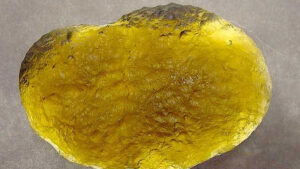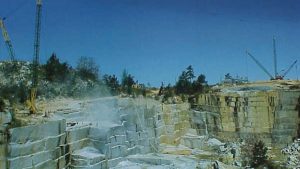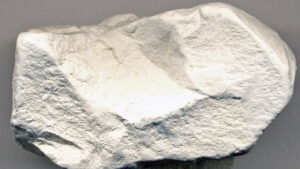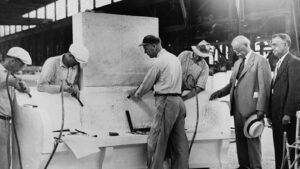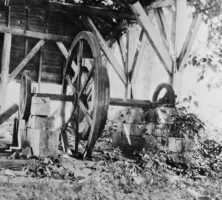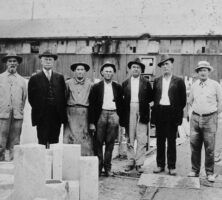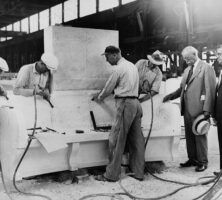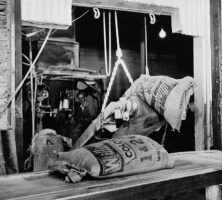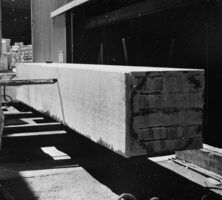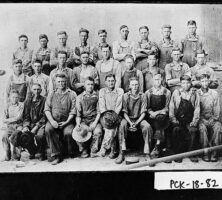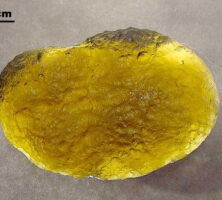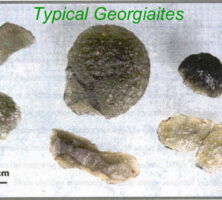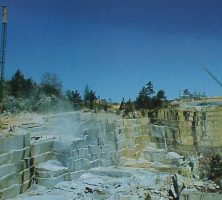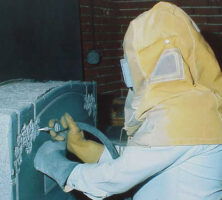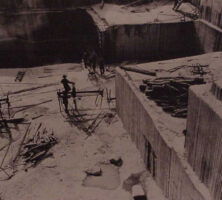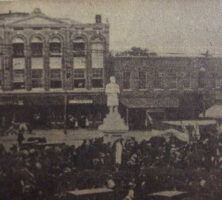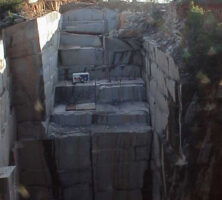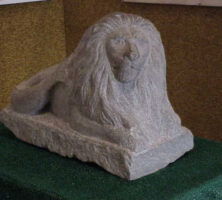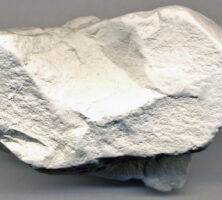The New Georgia Encyclopedia is supported by funding from A More Perfect Union, a special initiative of the National Endowment for the Humanities.
The state capitol building, completed in 1889, features a cornerstone, interior floor and steps, and many walls made of Georgia marble. Marble mined in the state was also used to construct 60 percent of the monuments and the U.S. Capitol in Washington, D.C.
Courtesy of Explore Georgia, Photograph by Ralph Daniel.
The New Georgia Encyclopedia does not hold the copyright for this media resource and can neither grant nor deny permission to republish or reproduce the image online or in print. Requests for permission to publish or reproduce the resource may need to be submitted to Explore Georgia.
A gang saw at the first plant built by the Georgia Marble Company in Pickens County is pictured circa 1885. The company was founded in 1884 by Samuel Tate, who in the 1830s purchased large tracts of land containing marble in north Georgia.
Courtesy of Georgia Archives, Vanishing Georgia, # pck285-85.
The New Georgia Encyclopedia does not hold the copyright for this media resource and can neither grant nor deny permission to republish or reproduce the image online or in print. Requests for permission to publish or reproduce the resource should be submitted to the Georgia Archives.
Colonel Sam Tate (second from left), the grandson of Georgia Marble Company founder Samuel Tate, poses with a group of foremen at the Pickens County plant, circa 1925. Colonel Sam served as president of the company from 1905 until his death in 1938.
Courtesy of Georgia Archives, Vanishing Georgia, # pck111-82.
The New Georgia Encyclopedia does not hold the copyright for this media resource and can neither grant nor deny permission to republish or reproduce the image online or in print. Requests for permission to publish or reproduce the resource should be submitted to the Georgia Archives.
Colonel Sam Tate, the president of the Georgia Marble Company, oversees the production of a marble bench in the Pickens County plant, circa 1930. The marble industry in the state prospered during the early 1930s but suffered losses from 1933 through the rest of the decade.
Courtesy of Georgia Archives, Vanishing Georgia, # pck250-85.
The New Georgia Encyclopedia does not hold the copyright for this media resource and can neither grant nor deny permission to republish or reproduce the image online or in print. Requests for permission to publish or reproduce the resource should be submitted to the Georgia Archives.
Sacks of ground or pulverized marble are produced at the Calcium Products Division of the Georgia Marble Company in Tate (Pickens County), circa 1950. The division was created in 1947 to sell "waste" marble, which is used as filler in paints and plastics. Ground marble products became the company's main product by the late 1980s.
Courtesy of Georgia Archives, Vanishing Georgia, #pck253-85.
The New Georgia Encyclopedia does not hold the copyright for this media resource and can neither grant nor deny permission to republish or reproduce the image online or in print. Requests for permission to publish or reproduce the resource should be submitted to the Georgia Archives.
Marble slabs used to make columns during reconstruction work on the U.S. Capitol in Washington, D.C., are cut at the Georgia Marble Company in Pickens County, circa 1958.
Courtesy of Georgia Archives, Vanishing Georgia, # pck043-82.
The New Georgia Encyclopedia does not hold the copyright for this media resource and can neither grant nor deny permission to republish or reproduce the image online or in print. Requests for permission to publish or reproduce the resource should be submitted to the Georgia Archives.
Workers for the Georgia Marble Company sit for a portrait during the 1920s at the Marblehill Quarry in Pickens County. Marble from Pickens County is reported to have been used in around 60 percent of the monuments in Washington, D.C.
Courtesy of Georgia Archives, Vanishing Georgia, #
pck018-82.
The New Georgia Encyclopedia does not hold the copyright for this media resource and can neither grant nor deny permission to republish or reproduce the image online or in print. Requests for permission to publish or reproduce the resource should be submitted to the Georgia Archives.
One of the largest tektites (or natural glasses) to be found in Georgia, this georgiaite was discovered in Dodge County in 2003. The glass is illuminated from behind to emphasize its translucent nature.
Photograph by Edward Albin
The New Georgia Encyclopedia does not hold the copyright for this media resource and can neither grant nor deny permission to republish or reproduce the image online or in print. All requests for permission to publish or reproduce the resource must be submitted to the rights holder.
Georgiaites, or tektites, are natural glasses formed when an asteroid or meteorite collides with the earth. Many scientists believe that georgiaites formed as a result of the meteorite impact that created the Chesapeake Bay Crater in Virginia around 35 million years ago.
Photograph by Edward Albin
The New Georgia Encyclopedia does not hold the copyright for this media resource and can neither grant nor deny permission to republish or reproduce the image online or in print. All requests for permission to publish or reproduce the resource must be submitted to the rights holder.
The Berkeley Quarry in Madison County, circa 1990. The quarry sits upon the Lexington-Oglesby Blue Granite Belt, which stretches from Elbert County to Oglethorpe and Madison counties. The Berkeley Quarry is one of many companies that contribute to the large granite industry centered in Elberton.
Courtesy of the Elberton Granite Association
The New Georgia Encyclopedia does not hold the copyright for this media resource and can neither grant nor deny permission to republish or reproduce the image online or in print. All requests for permission to publish or reproduce the resource must be submitted to the rights holder.
A worker sandblasting a granite monument.
Courtesy of the Elberton Granite Association
The New Georgia Encyclopedia does not hold the copyright for this media resource and can neither grant nor deny permission to republish or reproduce the image online or in print. All requests for permission to publish or reproduce the resource must be submitted to the rights holder.
The New Georgia Encyclopedia does not hold the copyright for this media resource and can neither grant nor deny permission to republish or reproduce the image online or in print. All requests for permission to publish or reproduce the resource must be submitted to the rights holder.
The Oglesby Quarry, circa 1935. The quarry sits upon the Lexington-Oglesby Blue Granite Belt, which stretches from Elbert County to Oglethorpe and Madison counties. The Oglesby Quarry is one of many companies that contribute to the large granite industry centered in Elberton.
Courtesy of the Elberton Granite Museum and Exhibit
The New Georgia Encyclopedia does not hold the copyright for this media resource and can neither grant nor deny permission to republish or reproduce the image online or in print. All requests for permission to publish or reproduce the resource must be submitted to the rights holder.
The unveiling of the statue that would come to be known as "Dutchy," on Elberton's town square, 1898. The statue depicts a Confederate soldier, but the figure is clothed in northern attire.
Courtesy of the Elberton Granite Museum and Exhibit
The New Georgia Encyclopedia does not hold the copyright for this media resource and can neither grant nor deny permission to republish or reproduce the image online or in print. All requests for permission to publish or reproduce the resource must be submitted to the rights holder.
Dutchy, now housed in the Elberton Granite Museum and Exhibit, once stood in Elberton's town square. The statue was so disliked by locals that they buried it in a hole near where it once stood. It was exhumed in 1982.
Photograph by Melinda S. Mullikin, New Georgia Encyclopedia
The New Georgia Encyclopedia does not hold the copyright for this media resource and can neither grant nor deny permission to republish or reproduce the image online or in print. All requests for permission to publish or reproduce the resource must be submitted to the rights holder.
The Pyramid Quarry in 2003. The quarry sits upon the Lexington-Oglesby Blue Granite Belt, which stretches from Elbert County to Oglethorpe and Madison counties. The Pyramid Quarry is one of many companies that contribute to the large granite industry centered in Elberton.
Photograph by Clay Ouzts
The New Georgia Encyclopedia does not hold the copyright for this media resource and can neither grant nor deny permission to republish or reproduce the image online or in print. All requests for permission to publish or reproduce the resource must be submitted to the rights holder.
This granite lion, housed in the Elberton Granite Museum and Exhibit, was carved by Italian workers for Peter Bertoni as a good luck charm.
Photograph by Clay Ouzts
The New Georgia Encyclopedia does not hold the copyright for this media resource and can neither grant nor deny permission to republish or reproduce the image online or in print. All requests for permission to publish or reproduce the resource must be submitted to the rights holder.
The New Georgia Encyclopedia does not hold the copyright for this media resource and can neither grant nor deny permission to republish or reproduce the image online or in print. All requests for permission to publish or reproduce the resource must be submitted to the rights holder.
The New Georgia Encyclopedia does not hold the copyright for this media resource and can neither grant nor deny permission to republish or reproduce the image online or in print. All requests for permission to publish or reproduce the resource must be submitted to the rights holder.
Hard kaolin is finely grained, difficult to break, and jagged in texture.
Image from James St. John
The New Georgia Encyclopedia does not hold the copyright for this media resource and can neither grant nor deny permission to republish or reproduce the image online or in print. All requests for permission to publish or reproduce the resource must be submitted to the rights holder.
